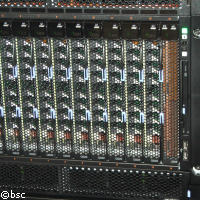New supercomputer prototype arrives
The Partnership for Advanced Computing in Europe (PRACE) has just received a new supercomputer prototype. Armed with this prototype it now has the means to investigate supercomputing of the future in a manner it has not been able to achieve before. PRACE aims to create the foundations for a pan-European high performance computing (HPC) service and infrastructure, the management of which will be handled as a single European entity. Funding for PRACE comes, in part, from the preparatory phase of the European Community's Seventh Framework Programme. Total funding from FP7 will amount to € 9.98 million. The supercomputer will be based in the Barcelona Supercomputing Center (BSC), which is one of PRACE's main partners and will be used in the MariCel initiative. MariCel, which in Catalan means Sea and Sky, will help to define the hardware components and the software stack of a future machine, the importance of which cannot be underplayed. 'MariCel is part of an initiative to create a common supercomputing structure for Europe,' commented Francesc Subirada, Associate Director of BSC. 'On this prototype, similar to the architecture of the American Roadrunner, we will test the latest software technologies, some of them developed at the BSC. We think that in Spain we will be able to install supercomputers 100 times more powerful than the current MareNostrum in 2011 or 2012,' he continued. The new supercomputer named American Roadrunner after the state bird of New Mexico, is the world's fastest and is capable of processing more than 1.026 quadrillion calculations per second. This makes it twice as fast as the world's previous supercomputer. Currently, only three European countries possess a supercomputer ranked in the world's top ten according to TOP500 which ranks and details the most powerful publicly known computer systems in the world. This list is updated twice a year, every year since 1993. As yet no European based model has ranked in the top 5. The mission of the BSC is to investigate, develop and manage information technology in order to facilitate scientific progress. Currently the BSC houses the MareNostrum, one of the world's most powerful supercomputers. The efforts of the scientists at the BSC will lead to the development of future systems which will have a minimum capacity of 10 Petaflops. That's ten times faster than the Roadrunner. This system will be at the service of the European scientific community. Scientists will be able to run climate change models in a mere fraction of the time it takes current supercomputers. PRACE is at the centre of building a pan-European High Performance Computing (HPC) Service. Such a huge undertaking necessitates the involvement of governments, funding agencies, as well as the scientific and industrial user communities with leading edge applications. The partnership builds on partners' experience and utilises concepts and services from EC-funded projects such as GEANT2 and DEISA. GEANT2, co-funded by the European Commission and Europe's national research and education networks, is a high-bandwidth academic Internet which serves Europe's research and education community. DEISA, on the other hand, is the Distributed European Infrastructure for Supercomputing Applications. This consortium of leading national supercomputing centres aims to foster leading computational science research at a pan-European level.



